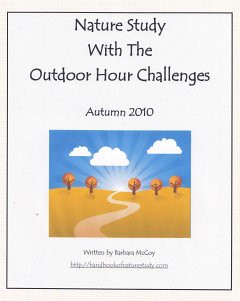- 10 Outdoor Hour Challenges-7 new challenges and 3 continuing studies (Seasonal Tree, Weather, and Queen Anne's Lace). All the Outdoor Hour Challenges in this ebook are based on the Handbook of Nature Study and include page numbers and suggested learning observations. The three on-going studies are totally revamped with an autumn focus and they will inspire you to continue in your year-long studies that you started in previous seasons.
- New to this series of challenges is the focus on learning to compare and contrast using a Venn Diagram. Full instructions and a notebook page are included.
- 16 Outdoor Hour Challenge notebook pages and nature journal suggestions.
- 4 optional coloring pages.
- Ideas for field trips other than your normal Outdoor Hour Challenge backyard adventures.
- Links for further enrichment for many of the challenges.
- Complete list of resources and instructions to get started with this ebook.
- 43 pages.
Autumn Nature Study plans sample:
Autumn 2010 Nature Study eBook Sample
Autumn Nature Study with the Outdoor Hour Challenges
Contains all the challenges, custom notebook pages, resource links, and coloring pages for nature study.
43 pages for $8.95.
Note: There might be a delay in you receiving the ebook in your inbox. I am emailing each book out myself and the delay can be up to 24 hours. I usually can send them a lot quicker than that. Also, I will be emailing the ebook to the email address on your Paypal.com account.

Edit to add 1/11/11: I would like to announce that you can now purchase all four seasonal ebooks for the Outdoor Hour Challenge in a bundle for a discounted price of $29.99. Click the button to order your bundle now. You will receive all four of the current seasonal ebooks.
If you have any questions, please email me: harmonyfinearts@yahoo.com.
Barb-Harmony Art Mom


























